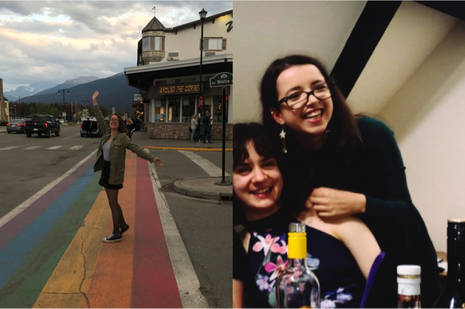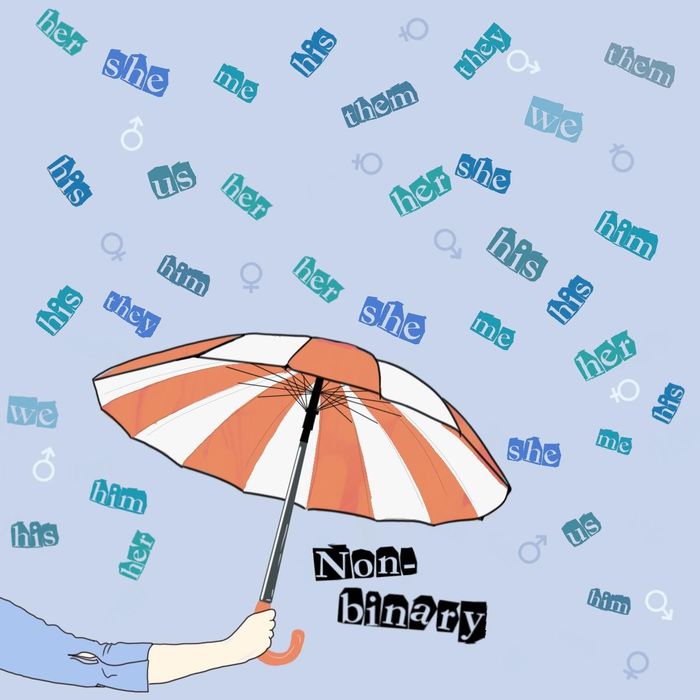On hair, labels, and queerness
Amy Howell reflects on how her queer identity growing up was shaped by external pressures and expectations, and how this changed on coming to Cambridge

Changing my hair’s style, cut, or colour has always felt like a very significant moment for me. This is partially because my brown waves, although nothing special, have always been the thing I liked most about my appearance. As a result, my development as a person, especially as a queer woman, is mirrored in my hair’s own journey.
For an uncomfortably long time, I was the only out person in my secondary school: it was a small school, with an even smaller LGBTQ+ community, making queerness an isolating experience. This isolation was not aided by my coming out experience being centred around a popular student announcing that I was a lesbian during a PSHE class (a label that I didn’t identify with, but came to adopt for several years following this incident). The months that followed involved several encounters with pink hair dye, flannels, and my hairdresser. I felt an immense, restrictive pressure to conform to the image of a ‘typical lesbian’ (when in reality, I was neither ‘typical’ nor a ‘lesbian’). At the time, I felt that society deemed that queerness was as much a personality trait and aesthetic as a romantic preference. I also felt obliged to accurately represent the whole LGBTQ+ community within my school (naturally an impossible task; synecdoche is more difficult to achieve outside of literary contexts, I learned).
“A series of labels – bisexual, of medium-length hair, pansexual, short-haired – floated around my mind”
This left me uncomfortable in my own sexuality, and the aesthetic manifestations of it. They both felt rather forced: ‘lesbian’ felt like an obligatory label forced upon me by my peers, rather than one I had chosen for myself. The flannel-wearing, flag-bearing image of myself was one indirectly painted by my peers. My sense of self suffered. With this intrinsic link between my hair and sexuality, naturally, my long-cherished hair no longer felt like my own, either.
Although I had distanced myself from the perceived obligation to wear flannels and put an LGBTQ+ flag in my Instagram bio by the time I reached sixth form, my hair remained comparatively short and my sense of style atypical. I found myself surprisingly comfortable in the formal dress code of my sixth form, with the prescribed blazers and shirts being more medicinal for me, rather than being the cause of common-room anguish as they seemed to be for my peers. As I allowed myself to enjoy, for the first time, a sense of style that I considered my own, I felt more like myself than I had done in a long time, especially with the absence of my GCSE peers who made my queerness the topic of their conversation.
The bob haircut endured for the rest of my secondary school career, until lockdown made hairdressers inaccessible. This was around the time that my relationship with my first boyfriend, having only dated women prior to this, came to an end. This boyfriend was a tangible representation, in a series of Instagram posts, that I was not a lesbian, but that I existed somewhere in-between.
It was no coincidence that my internal dilemma as to how to classify my romantic preferences peaked when hairdressers were accessible once more: I debated extensively whether my now collarbone-length hair, which I felt oddly uncomfortable with at first, was to be removed at the earliest opportunity or not. A series of labels – bisexual, of medium-length hair, pansexual, short-haired – floated around my mind, none of which feel like quite the right fit to this day. I questioned whether a perfect label was necessary for my sexuality to form part of my identity, and if it was detached from that identity, whether I had a place among the LGBTQ+ community.
Existing outside of these labels and having left behind some of the perceived aesthetic obligations of queerness left me feeling insufficiently queer to participate in the LGBTQ+ community upon my arrival in Cambridge. This feeling of inadequacy made me too nervous to join my College’s LGBTQ+ group chat until the beginning of Lent term, leaving me to navigate how to approach and discuss my sexuality with my newfound peers with little guidance.
Moving past that inadequacy and participating in the opportunities to meet other LGBTQ+ students at my College was one of the best things I did during Lent term: I felt as though I’d gone from feeling overly defined by my sexuality, to having become overly detached from it, and then finally finding a middle ground, where my still-atypical fashion sense and the absence of feelings of isolation (two things which I previously believed to be mutually exclusive) were reconciled. Being welcomed by LGBTQ+ students at Clare was an immense sigh of relief, with a range of hobbies, preferences and academic disciplines being represented: the community, for me, is one that celebrates our differences as much as our shared experiences as LGBTQ+ people. This celebration provides a space for these experiences to be and remain a part of our perception of our own selves, but without it defining every part of ourselves.
 Features / Should I stay or should I go? Cambridge students and alumni reflect on how their memories stay with them15 December 2025
Features / Should I stay or should I go? Cambridge students and alumni reflect on how their memories stay with them15 December 2025 News / Cambridge study finds students learn better with notes than AI13 December 2025
News / Cambridge study finds students learn better with notes than AI13 December 2025 News / Dons warn PM about Vet School closure16 December 2025
News / Dons warn PM about Vet School closure16 December 2025 Comment / The magic of an eight-week term15 December 2025
Comment / The magic of an eight-week term15 December 2025 News / News In Brief: Michaelmas marriages, monogamous mammals, and messaging manipulation15 December 2025
News / News In Brief: Michaelmas marriages, monogamous mammals, and messaging manipulation15 December 2025










